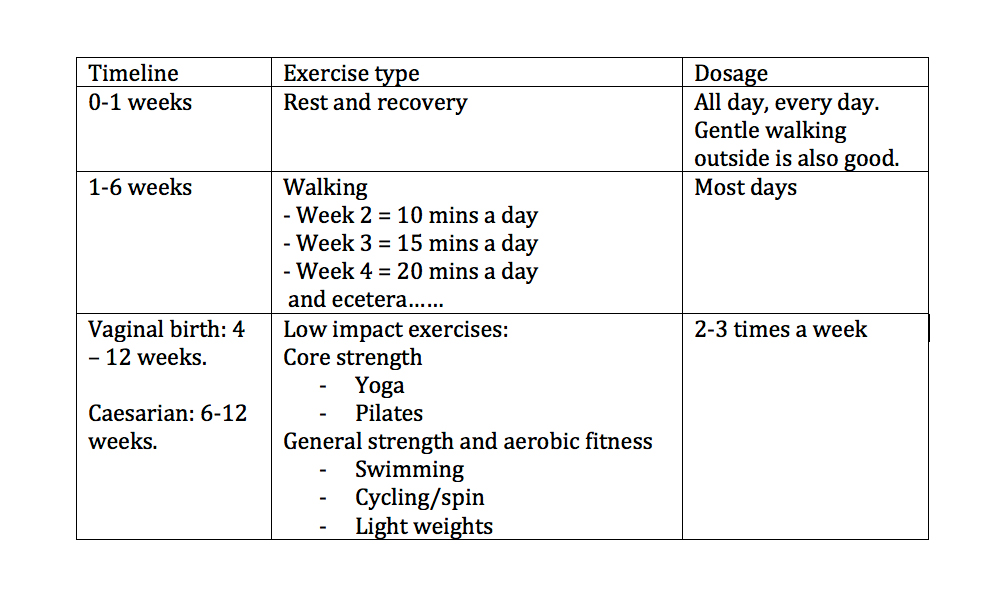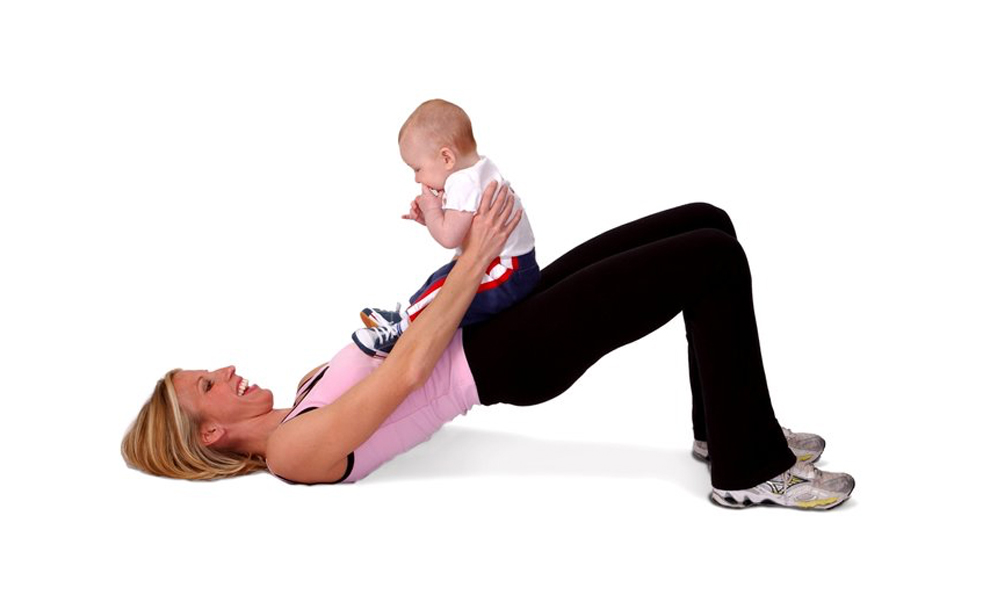Recovery and exercise after childbirth
After the first week of rest and recovery, it’s time to start thinking of a regular exercise regime. Yes, I know you’re exhausted and dazed and confused, and the last thing you feel like doing is putting on lycra, strapping your boobs into a sports bra and bouncing around. BUT exercise will make you feel better! Exercise helps to improve core strength, improve mood, lose weight and prevent new mum aches and pains. However, some forms of exercise can be harmful for your pelvic floor, abdominal separation and your joints, and can cause long term damage.
It takes 6 weeks for new, scar tissue to be laid down over injured areas, so downward force on the pelvic floor and incorrect abdominal exercises should be avoided. From 6-12 weeks post natal, this soft tissue is being strengthened by stronger tissue and your body still has the ‘stretchy’ hormones acting on it. So progressive strengthening is good but exercises should still be modified. The timeline for vaginal birth vs caesarian birth is similar; just give yourself the first 6 weeks to recover after caesar, and 4 weeks after vaginal birth, whilst doing gentle exercise.
Timeline after birth:

The first 6 weeks after childbirth:
For the first 6 weeks post natal, start by getting out and walking most days. Start with 10 mins a day initially, 15 mins a day the following week, 20 mins the following week etc, so that at 6 weeks post natal, you are walking 45 mins most days.
You can start other low impact exercise 4 weeks after vaginal birth, and 6 weeks after a caesarian birth. Remember, your pelvic floor, joints, and abdominals are still recovering! So take it easy ladies, and rest horizontally for 30 mins after exercise (when your baby naps, have a rest).
Low impact forms of exercise include:
- walking
- post natal yoga or pilates (ideally run by physio)
- cycling/spin (once your bits are comfortable on a seat)
- swimming (once you’ve stopped bleeding)
- light weights (nothing heavier than your baby and best to do lying down initially, then sitting on a Swiss ball for core stability)
Potentially harmful exercises include:
- full sit ups: You can do deep abdominal exercises that work the lower and deepest part of your abdominals (transversus abdominus muscle). This muscle gives you your waist shape, and gives you a flatter tummy (NB full sit ups do not give you a flat tummy! In fact they often shorten your upper tummy, and bulge out the lower tummy).
- full planks
- double leg lowers
- high impact exercise (ie running, jumping, star jumps, aerobics)
- heavy weights
Returning to these types of exercise too quickly after childbirth can cause prolapse, incontinence, back pain, and can disrupt the healing of any abdominal separation.
12 weeks after childbirth:
Now, finally, your pregnancy hormones have left your body. However, if you are breastfeeding, the lack of oestrogen in your body means that you are still prone to musculoskeletal injury.
If you are looking to get back into high impact exercise (running, aerobics, sports that include jumping) be sure to check your pelvic floor by doing the following test:
10 star jumps, with a full bladder, whilst coughing at the same time.
Sounds frightening, right? This is the amount of stress your pelvic floor has to withstand when doing high impact exercise. If you can perform the above, without leaking urine or feeling heaviness or bulging in the vagina (indicative of a prolapse) then you are probably good to return to high impact exercise. If you have risk factors for pelvic floor dysfunction however, I would recommend a pelvic floor check with a physio, even if you feel fine. Remember, you should return to high impact slowly, and gradually, probably slower than you would have pre-pregnancy to avoid injury. It is also a fab idea to do this in conjunction with a physio and some form of core strength exercise ie Pilates.
There are many post-natal group exercise classes out there. Armed with this blog information and go and try some classes out. Use your common sense, if it feels wrong, it probably is. Exercise classes run by women’s health physios are safe, and targeted specifically to what your body needs now. Remember, every post natal body is different so if you have concerns, please see your pelvic floor physio and ask them to work with your personal trainer.
If this all sounds too confusing, I say this; Get outside and walk most days, and do physio prescribed pilates 2x a week, then give yourself a pat on the back, a high five and a bones, sister. You’re doing a choice job of looking after yourself. Most importantly, make sure you are doing your pelvic floor exercises 3x a day, every day, and progressing them each week!
So, go forth and exercise!

